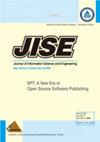基于规则的L - T - X数学方程到内容MathML (cml)的转换
IF 1.1
4区 计算机科学
Q4 COMPUTER SCIENCE, INFORMATION SYSTEMS
Journal of Information Science and Engineering
Pub Date : 2020-09-01
DOI:10.6688/JISE.202009_36(5).0006
引用次数: 1
摘要
本文讨论了LATEX数学方程数学语法规则的形成。这些规则用于生成抽象语法树(AST), AST从以LATEX格式给出的数学表达式中提取结构信息。后来使用AST生成数学表达式的XML结构,使数学表达式在异构环境中具有机器可读性。提出了一种基于规则的算法,将LATEX数学表达式转换为内容MathML (Content MathML),从而在web文档中产生语义丰富。LATEX数学公式的编写规则被表述为LATEX数学语法(LATEX math Grammar, LMG),用于生成AST,并将AST转换为XML结构,用于生成cml编码。首先,在ntcirr -12数学竞赛中使用的20个方程上测试了转换算法,然后在ntcirr -12 Wikipedia-MathIR和ArXiv数据集上测试了该算法。结果表明,与现有算法相比,该算法能够将LATEX复杂方程广泛地转换为cml,并且时间效率优于现有系统。本文章由计算机程序翻译,如有差异,请以英文原文为准。
Rule Based Conversion of L A T E X Math Equations into Content MathML (CMML)
This paper discusses the formation of math grammar rules for LATEX math equations. These rules are used to generate Abstract Syntax Tree (AST) which extracts structural information from mathematical expressions given in LATEX format. Later AST is used to generate XML structure of mathematical expressions that make mathematical expressions machine-readable in heterogeneous environments. A rule-based algorithm is also proposed that converts LATEX math expressions into Content MathML (CMML), which produces semantic enrichment in web documents. The rules for writing LATEX math equations are formulated and implemented as LATEX Math Grammar (LMG), which are used for generating AST. Further, AST is converted into XML structure which is used to generate CMML encoding. Initially, the conversion algorithm is tested on 20 equations used in an NTCIR-12 math competition, then the algorithm is tested on NTCIR-12 Wikipedia-MathIR and ArXiv data sets. The results show that our algorithm is capable of converting LATEX complex equations into CMML extensively as compared to the existing ones as well as its time efficiency is better than contemporary systems.
求助全文
通过发布文献求助,成功后即可免费获取论文全文。
去求助
来源期刊

Journal of Information Science and Engineering
工程技术-计算机:信息系统
CiteScore
2.00
自引率
0.00%
发文量
4
审稿时长
8 months
期刊介绍:
The Journal of Information Science and Engineering is dedicated to the dissemination of information on computer science, computer engineering, and computer systems. This journal encourages articles on original research in the areas of computer hardware, software, man-machine interface, theory and applications. tutorial papers in the above-mentioned areas, and state-of-the-art papers on various aspects of computer systems and applications.
 求助内容:
求助内容: 应助结果提醒方式:
应助结果提醒方式:


